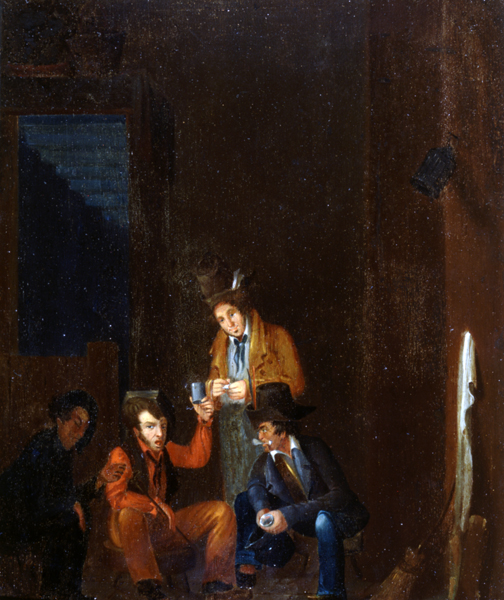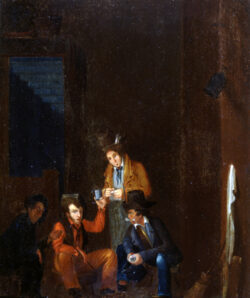Jean and Pierre Laffite
Of all the storied characters in Louisiana's early history, two brothers Jean and Pierre Laffite rank among the most notorious and noteworthy.

Courtesy of Louisiana State Museum
Color reproduction of a painting by Ezra Ames, long mistakenly believed to represent Jean Laffite and still evocative of his persona.
Of all the storied characters in Louisiana’s early history, two brothers—Jean and Pierre Laffite—rank among the most notorious and noteworthy. As with almost all pirates and privateers, the lives of the Laffites spawned numerous tales of secret gold and hidden treasure. As is the case with virtually all such treasure tales, they are nonsense. Remarkably little is known of their lives, and much assumed common knowledge is myth.
Early Lives
Pierre and Jean Laffite (also commonly spelled Lafitte in contemporary histories) were born in the village of Pauillac on the Gironde estuary in the Medoc region of France. Their father was the merchant Pierre Laffite, but they appear to have had different mothers. Pierre and Marie Lagrange had Pierre Jr. in about 1770. After Marie’s death, Pierre married Marguerite Desteil in 1775, who gave birth to Jean around 1782. The half-brothers grew up in Pauillac and, later, in Bordeaux, where they received a limited education. Their father died in 1796, by which time Pierre may already have visited St. Domingue, where Jean or another brother already made his home. It is clear that Pierre Laffite left France for Louisiana by May 1802. He stopped at Cap Français on the way and narrowly escaped the street fighting as French troops battled Black revolutionaries in the Saint-Domingue Revolution (1791–1803). By March 1803, Pierre had reached New Orleans, bringing with him a mulatto mistress and a son.
During the next ten years, Pierre lived in New Orleans, Baton Rouge, and Pensacola. He was a merchant, but it is almost certain that neither he nor Jean was ever a blacksmith as popular legend holds. In 1804, he began working in the slave trade, foreshadowing the Laffite brothers’ future enterprise. In 1805, he took a new mulatto mistress, Marie Louise Villard, with whom he had several children over the next fifteen years.
Meanwhile, Jean Laffite’s activities are virtually unknown from the time of his birth until 1809, when he was in New Orleans. Around the same time, Pierre relocated from Pensacola, putting the two brothers in the same place at the same time. Jean probably spent some years at sea, possibly as a privateer. In November 1809, one New Orleanian referred to him as “the notorious Captain Laffitte,” suggesting that he had achieved a level of notoriety, probably stemming from his activities in the slave trade. He reportedly imported enslaved people who had been captured by illicit Spanish privateers, smuggling them into Louisiana through Barataria Bay and other isolated spots on the coast. Rather than operating his own vessel, Jean Laffite may have been working as a middleman between the privateers and his brother, Pierre, who marketed the captives in and around New Orleans. All of these activities violated the 1808 law abolishing the foreign slave trade.
Life in Louisiana
The Laffite brothers made influential connections in New Orleans and successfully operated for years, in spite of various efforts to stop them. Though they were not the only smugglers in the region, they evolved into the most effective entrepreneurs, especially after President Thomas Jefferson’s Embargo and Nonintercourse Acts of 1807 stopped the flow of imported goods from Europe. When the War of 1812 erupted, the brothers’ business flourished as the British blockade further constricted the flow of imports. Soon they acquired ships of their own and questionable letters of marque—permitting private vessels to seize and capture enemy ships—from shadowy Central American juntas that enabled them to prey on Spanish merchantmen. It appears that Pierre was never a seaman and his health was not good; he may have had a stroke or epilepsy.
In August 1814, British officers intending to attack New Orleans during the War of 1812 attempted to engage the Laffites’ assistance, but Jean declined. Despite this show of loyalty, that September US naval forces attacked and destroyed the Laffites’ base in Barataria Bay, seizing all of their ships. The brothers fled to the interior, but Jean soon bartered their services to the authorities in return for pardons. During the Battle of New Orleans in 1815, Jean seems to have been in the bayous guarding a possible backdoor approach to the city, while Pierre acted as a guide on the American army’s right flank and saw some limited skirmishing. It was later claimed that the Laffites provided much-needed cannon for the American army, but in fact virtually all of their artillery was lost with their base in Barataria. The brothers did provide several thousand musket flints to Andrew Jackson’s army, and some of their followers did act as artillerymen in the battle, but their role was peripheral and hardly as decisive as the legend claims.
The government made good on its promise of pardons, but the Laffites returned almost immediately to smuggling. They became deeply involved with a plot hatched by the New Orleans Association—a group of businessmen interested in seizing Mexico and Central and South America for themselves or the United States—with operations centered on Galveston Island. The Laffites acted in concert with the association and its filibuster allies until 1820, while simultaneously working as paid spies for Spain and reporting on the association’s plans. They set up a base in Galveston to receive goods from privateers and operated a thriving market for Louisiana planters who came to buy enslaved people and other merchandise.
By May 1820, the United States had had enough of the illicit operation and persuaded the Laffites to close down, on threat of being forced out by naval forces. Jean destroyed the Galveston establishment and set off with three ships, reportedly to become a privateer for a junta in Colombia, Venezuela, or Buenos Aires. In fact, he had no letters of marque from any of them. When he took a few Spanish prizes he was, for the first time, a genuine pirate. Meanwhile, Pierre closed the brothers’ affairs in New Orleans and went to Charleston, South Carolina, to buy a ship and enlist a crew for privateering. In March 1821, he established a base of operations at Isla de Mugeres [now usually spelled “Mujeres”] off the Yucatán and took a few prizes, but Spanish authorities soon sent a party to drive him out. On October 30, these authorities attacked and captured Pierre and a few others. Though he quickly escaped, Pierre may have been wounded in the skirmish or ill at the time of the attack, since he almost immediately fell into a severe fever. Pierre died on or about November 9, 1821. The next day, he was buried in the churchyard of the old convent Santa Clara of Dzidzantún in northeastern Yucatán.
After his brief career as a pirate, Jean Laffite obtained a privateering commission from Colombian rebels and took command of the General Santander. On February 4, 1823, he ran into two small Spanish warships that he could not outrun. In the fight that erupted, Laffite fell mortally wounded and was buried at sea the next day.
Once the Laffites were gone, there was little left by which to remember them, except stories that quickly grew into legend. Pirates and privateers were by nature profligate; they did not hide or bury money or treasure goods. When they got money, they spent it, and then went out after more. Virtually all of them died in obscurity as paupers. The Laffites’ genuine impact on their times was minimal. The Battle of New Orleans would have been won without them. Galveston Island would have been settled without them, and it was soon repopulated after they left. Their schemes for Mexican conquest came to nothing. In fact, their chief impact on Louisiana’s history was as folk heroes, their legend quickly overwhelming the reality of their lives and growing out of all proportion to the men themselves. In the case of the younger brother, the legend endures among institutional namesakes–the village of Jean Lafitte and the unincorporated Lafitte community in Jefferson Parish, as well as Jean Lafitte National Historical Park and Preserve, which encompasses six sites across a 200-mile swath of South Louisiana.
